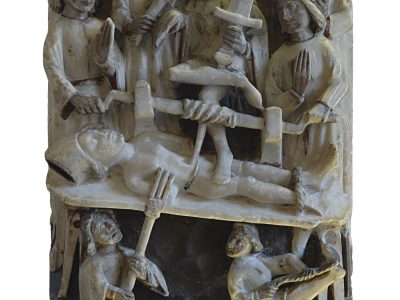The Martyrdom of St Erasmus (Alabaster)
This tablet depicts the martyrdom of St Erasmus, a bishop from Formiae in Campania, Italy. According to Christian tradition St Erasmus died in the year AD303 during the Tetrarchy of the Roman Emperors of the west, Maximian and Diocletian. Erasmus was alleged to have been repeatedly tortured for continuing to preach Christian doctrine but was miraculously healed by an angel until he was finally executed. This alabaster was once a part of an altar or shrine (reredos).
During the fifteenth and sixteenth centuries, craftsmen in England carved and decorated images from alabaster, a form of gypsum that is relatively soft and easy to carve but which allows for fine and sharp detailing. Alabasters were often painted and gilded, creating a vibrancy that also provided an additional means of highlighting detail through use of colour as well as depth of carving. These sculptured images and tablets were displayed in churches as altarpieces, and in chapels, palaces, ordinary homes, and even workshops. Quality varied, from the rough and stylistic to the very fine and exquisite depending on the craftsmen, with many surviving examples showcasing the particular skill of the English workshops.
